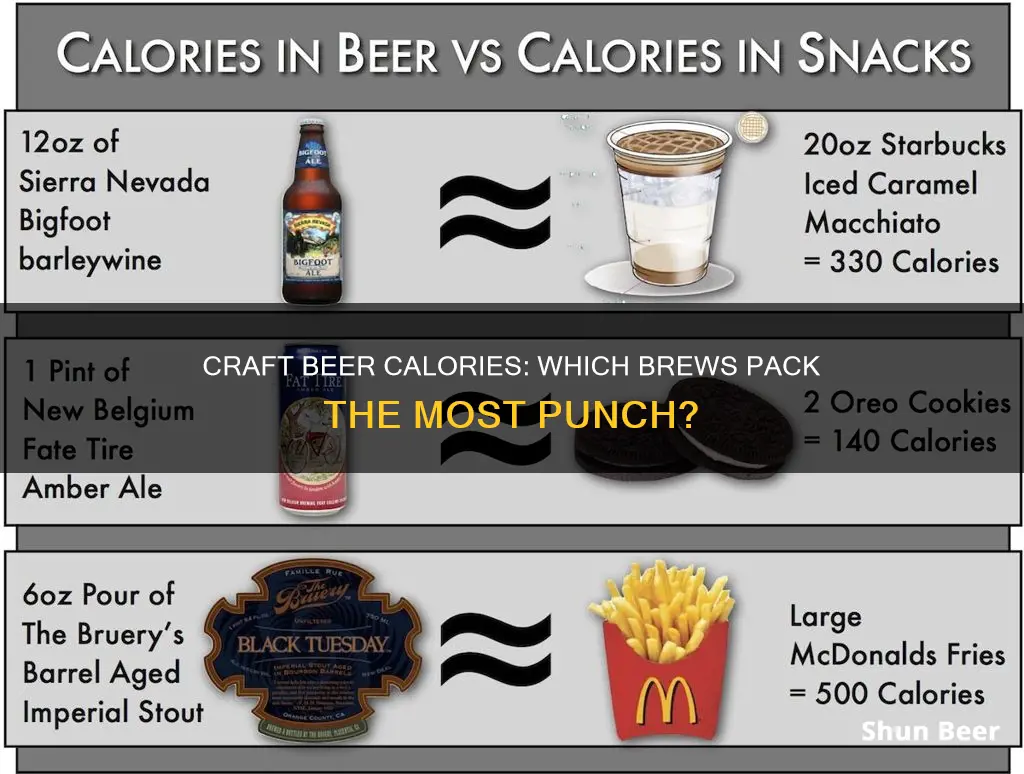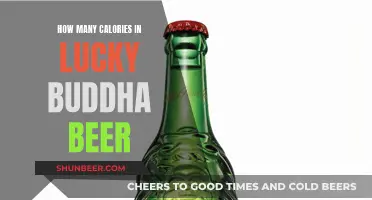
Beer is a popular drink worldwide, but with its high calorie count, it can be a dieter's nightmare. The calorie content of beer depends on its alcohol and carbohydrate content. Craft beers, seasonal beers, and beers with high alcohol content tend to have more calories than lighter beers. IPAs, for example, can have over 300 calories in a 12-ounce serving, while a typical 12-ounce beer has around 140 calories. However, some craft breweries are now offering low-calorie options, with some IPAs containing fewer than 100 calories per serving. So, if you're watching your waistline but still want to enjoy a craft beer, there are options available that won't break the calorie bank.
| Characteristics | Values |
|---|---|
| Calories | Varies, but can be as low as 60 calories in 12 oz. for very-low-alcohol beers (2% to 3% alcohol) |
| ABV | The higher the ABV, the more calories in the beer |
| Carbohydrates | 40% of calories in beer come from carbohydrates |
| Alcohol | 60% of calories in beer come from alcohol |
| Style | Lagers usually have fewer calories than ales, and ales fewer than stouts |
What You'll Learn

Calories in beer come from alcohol and residual sugar
Calories in beer mainly come from two sources: alcohol and residual sugar. The more alcohol a beer contains, the more calories it will have. This is because alcohol contains more calories per 100 milliliters than carbohydrates.
Beer is made from grains and yeast, and the calorie content can vary widely depending on the type of beer. For example, light beers tend to have between 60 and 120 calories, while dark beers have between 100 and 300 calories. Dark beers are more carbohydrate-heavy, which contributes to their higher calorie content.
The amount of sugar in beer also depends on the type of beer and the ingredients used. For instance, light beers tend to have slightly more sugar than regular beers due to differences in their fermentation process. Non-alcoholic beers have the highest sugar content because none of the sugar is converted into alcohol.
In addition to alcohol and residual sugar, carbohydrates also contribute to the calorie content of beer. However, beer is not a significant source of sugar, as most of the sugar in the brewing process is fermented into alcohol.
When it comes to craft beer, those with higher alcohol content will generally have more calories. So, if you're looking for a lower-calorie option, opt for craft beers with lower alcohol content or alcohol-free beers.
Beer Calories and Carbs: What's the Count?
You may want to see also

Beer with higher alcohol content has more calories
The calories in beer come mainly from two sources: alcohol and residual sugar. Therefore, beers with higher alcohol content will tend to have more calories than those with lower alcohol content. A beer's calories depend mostly on its alcohol content and, to a lesser extent, its carbohydrate content.
A typical 12-ounce beer has around 140 calories, which is similar to a can of Coke. However, some beers can have twice as many calories. For example, a 16- or 20-ounce draft pour of an average beer can contain 200-250 calories.
The calorie content of beer can vary widely depending on its alcohol percentage. Very low-alcohol beers (2-3% alcohol) typically start at around 60 calories for a 12-ounce serving. Most light beers (4% alcohol) have about 100 calories, while regular beers (5% alcohol) average around 150 calories. Heavy hitters like IPAs, double or imperial IPAs, and Belgian-style Trippels (7-11% alcohol) can pack 200 to 300 calories per serving.
Craft beers, seasonal beers, and beers with high alcohol content tend to have more calories than lighter beers. If you're watching your calorie intake, opt for low-alcohol or alcohol-free beers, as these usually contain fewer calories.
In addition to alcohol content, other factors such as ingredients, brewing techniques, and serving size can also influence the calorie content of beer. However, alcohol content remains the primary determinant of a beer's calorie count.
Calories in Hopadillo Beer: What's the Count?
You may want to see also

Lagers have fewer calories than ales, and ales fewer than stouts
The calorie content of beer depends on a few factors, mainly alcohol content, and to a lesser extent, carbohydrates. Generally, lagers have fewer calories than ales, and ales fewer than stouts.
Lagers tend to have less alcohol and fewer carbohydrates, so they are usually lower in calories than ales and stouts. A typical pint of lager has about 160-185 calories, but this can vary depending on the brand and alcohol content. Some premium lagers can have up to 338 calories per pint.
Ales, such as IPAs, tend to have a higher alcohol content and can range from 140 to 300 calories. For example, a regular 5% alcohol brew like Budweiser has around 150 calories, while heavy hitters like double or imperial IPAs can pack 200 to 300 calories.
Stouts also tend to have a higher alcohol content and can range from 126 to 192 calories per 12 ounces. For example, Guinness Extra has 126 calories and 5.6% alcohol, while Murphy's Irish dark beer contains 192 calories and 4% alcohol.
It's worth noting that non-alcoholic beers are usually lower in calories, ranging from 45 to 150 calories per 12 ounces. So, if you're watching your calorie intake, opting for a non-alcoholic beer or a lager with a lower alcohol content is a good strategy.
Additionally, the type of grains and fermentation process can impact the calorie content of beer. For example, beers made with malted barley and other grains that release sugars during fermentation may have more unfermented sugar and, therefore, higher calories.
When it comes to craft beer, the calorie content can vary widely depending on the style and ingredients. However, some craft beers can be quite low in calories, with some options ranging from 55 to 140 calories per 12 ounces.
Calories in Mythos Beer: A Comprehensive Breakdown
You may want to see also

Light beers have fewer calories
It's true that light beers have fewer calories. The definition of "light beer" varies among brands, but it generally means that the beer contains less alcohol, fewer calories, or both. Light beers are crafted by lowering the number of carbohydrates that come from malt and grains, as well as reducing the alcohol content.
When it comes to calories, beer mainly depends on its alcohol content and, to a lesser extent, its carbohydrate content. A typical 12-ounce beer has around 140 calories, similar to a can of Coke. However, some beers have twice as many calories.
If you're watching your calorie intake, opting for light beers can be a good strategy. Here are some examples of light beers with fewer calories:
- Budweiser Select 55: With just 55 calories and 1.9 grams of carbohydrates per 12-ounce serving, this beer is one of the lightest options available.
- Miller Lite: Miller Lite contains 96 calories and 3.2 grams of carbohydrates per 12-ounce serving, making it a lighter choice.
- Coors Light: Coors Light offers 102 calories and 5 grams of carbohydrates per 12-ounce serving, slightly lower than its competitor Bud Light.
- Amstel Light: Amstel Light has been a crowd favorite for over 150 years, offering a delicious mix of barley malt and hops with fewer than 100 calories.
- Yuengling Light Lager: This light lager from Yuengling has fewer than 100 calories, maintaining the flavor profile of their flagship beverage with its caramel malt and mild hop character.
These are just a few examples of light beers with fewer calories. When choosing a light beer, remember to check the nutritional information and look for options with reduced alcohol content and lower carbohydrate levels.
In addition to light beers, non-alcoholic and low-alcohol beers are also good options for reducing calorie intake. These beers have a lower concentration of alcohol, which can contribute to healthier drinking habits.
Calorie Count in Dos Equis Beer: What You Need to Know
You may want to see also

Low-calorie beers have a low ABV
While it is true that low-calorie beers tend to have a lower ABV, this is not always the case. The number of calories in beer depends on two main factors: alcohol content and residual sugar. Therefore, any beer with a high attenuation rate, or the percentage of sugar converted to alcohol, can be considered low-calorie.
For example, Le Petit Prince by Jester King Brewery is a low-calorie beer with only 75 calories per can, but it has an ABV of 2.9%, which is higher than some regular beers. Similarly, the Gnome Blonde by The Grateful Gnome Sandwich Shoppe & Brewery has 120 calories and an ABV of 4.5%.
However, it is important to note that the relationship between calories and ABV is not linear. Beers with a higher ABV will generally have more calories, but the specific ingredients and brewing processes can also affect the calorie count. For instance, Dogfish Head Slightly Mighty IPA has an ABV of only 4% but contains 95 calories due to the use of monk fruit, which boosts its body and complexity without adding calories.
Ultimately, while low-calorie beers often have a lower ABV, it is not the sole factor determining the calorie content. Brewing techniques, ingredients, and the attenuation rate can also play a significant role in reducing the number of calories in a beer.
Wheat Beer Calories: What's the Count?
You may want to see also
Frequently asked questions
Beers with higher alcohol content will generally have more calories. IPAs tend to be heavy hitters, with regular, double, or imperial IPAs packing 200 to 300 calories in a 12 oz serving.
If you're looking for lower-calorie craft beers, there are several options available. Here are some examples:
- Le Petit Prince by Jester King Brewery (75 calories)
- Scrimshaw by North Coast Brewing Co. (100 calories)
- Gnome Blonde by The Grateful Gnome Sandwich Shoppe & Brewery (120 calories)
- Easy Jack by Firestone Walker Brewing Company (120 calories)
- River Trip by Allagash Brewing Company (128 calories)
The calories in a beer depend mainly on its alcohol content and, to a lesser extent, its carbohydrate content. You can use the following formula to estimate the number of calories:
Beer calories = ABV% x 2.5 x ounces of beer
For example, a 12 oz beer with 5% ABV would have approximately 150 calories.
Yes, here are a few strategies to consider:
- Opt for low-calorie craft beers, which tend to have a low ABV, typically 4.5% or less.
- Choose "light" beers, which usually have fewer calories due to lower carbohydrate and alcohol content.
- Drink in moderation. Sipping and savouring your beer slowly can help you enjoy the unique flavour while reducing the number of beers consumed.







